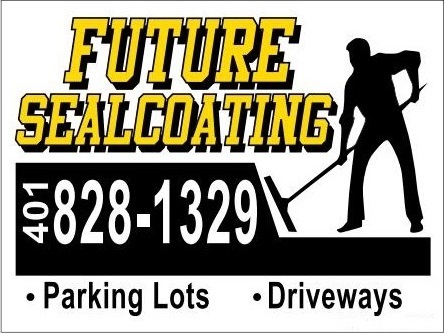Frequently Asked Questions
WHAT ARE THE BEST WEATHER CONDITIONS & WHEN IS THE BEST TIME OF YEAR FOR SEALCOATING MY DRIVEWAY/PARKING LOT?
Sealer application season is between the months of April-November. Temperature is a key factor in sealer application - ideally to be between 40 - 95 degrees. However, it is not the only factor. When scheduling your project we also take into consideration the asphalts' sun exposure or lack thereof, humidity, wind speed, surface texture, and whether or not the asphalt is new, old, and/or previously sealcoated. These many factors are why Future Sealcoating does not schedule projects too far in advance. Rhode Island weather is constantly changing and we want to ensure the day and time we schedule your project is ideal for YOUR project. We're a personal company that wants your personal experience with us to be a great one.
HOW OFTEN SHOULD I SEALCOAT MY DRIVEWAY OR PARKING LOT/how long will the coating last?
Sealer applied by a professional company should last anywhere from 2-5 years before needing to be re-applied. However, there are some other factors that contribute greatly to the life of the coating. Typically sealer on a commercial parking lot will wear much faster than a home driveway due to seeing much more vehicle traffic. Methods of snow removal, such as frequent, rough plowing will definitely affect the life of the coating as well. Also leaving excessive amounts of sand and salt on the surface, when it isn't needed, will all contribute towards premature wear (think sandpaper on paint).
DO YOU GUYS "LAY IT ON THICK"?
This concept of putting sealer on “thick” is a misunderstanding of the nature of the product and how it is applied. Sealer is a liquid, not a solid, and is applied in 2 different methods.
When sealer is applied properly, by hand with a brush, it goes on at a completely even consistency; the material goes down in a puddle-like form and then gets brushed across the entire driveway surface evenly. This ensures that EVERY SQUARE INCH OF PAVEMENT HAS THE EXACT SAME AMOUNT OF SEALER APPLIED TO IT.
When applied by spraying, the goal of the operator is, again, providing EVEN COVERAGE, ensuring that the entire surface is coated with the same amount of sealer. We perform both of these methods of application using decades of skill and experience in our profession, and pride ourselves in how neat and uniform our work is.
Can you fill in/level this low spot on my driveway/parking lot?
There is no way to properly build up or level any low spot on a driveway/parking lot other than cutting out the depressed area, and repaving it. We offer hot asphalt patching to repair potholes, and significantly deep, sunken spots; but sealer is a liquid, serving like a protective paint for your driveway, and does not possess the ability to change the symmetry of asphalt.
IS CRACK FILLING IMPORTANT?
Filling any breaches in your driveway or parking lot is THE most important maintenance precaution you can take to prolong the life of the asphalt. By filling the cracks, you help seal out water from passing through and under the surface of your asphalt. If left unsealed, that water would then freeze and expand, causing more damage. Over time small cracks become larger ones, and can eventually lead to whole portions of the asphalt having to be replaced, which makes crack filling not only essential in preserving pavement, but will prove much more cost effective in the long run, over needing to replace your pavement.
SHOULD I SEALCOAT MY DRIVEWAY MYSELF?
That choice is up to you, but any professional company would NOT recommend it. The materials available to professionals are commercial grade and obtained from a registered distributor of the product. To each batch of sealer we also have our own additive mix that helps the longevity, texture, color, and traction of the product. And because these are all correctly mixed up in one large batch, you're insured the end result will be uniform, as opposed to a bunch of separate buckets purchased at a home improvement store.
WHY ARE THERE TIRE PRINTS OR SCUFFING ON THE ASPHALT AFTER SEALCOATING AND/OR CRACK FILLING?
We recommend waiting a full 24-48 hours (depending upon humidity) before driving back in on your sealed asphalt. However, it takes about 2-3 weeks for sealer to cure fully. During that time, and due to certain conditions, you may notice some scuffing or tire prints on the asphalt - this is normal and will wear in within 1-2 weeks.
As for crack filler, that product can go from "squishy" to solid depending on ambient temperatures. This materials' main feature is to flex, and maintain a seal, while allowing asphalt to expand and shrink during hot and cold temperatures. On a hot day you may notice some tire prints - these are also normal and will wear in over time.
HOW DO I MAINTAIN AND CARE FOR MY ASPHALT AFTER IT'S SEALCOATED?
As mentioned above, keeping off excessive amounts of sand, salt, dirt, etc. (anything abrasive).
Keep all fertilizers and mulch off of the asphalt, as these can leave stains and/or damage the coating. If these do get on your asphalt REMOVE THEM IMMEDIATELY with a leaf blower and/or water.
Once coated, your asphalt now has a protective barrier against oil and gas spills. However, if you do have an oil or gas spill we strongly recommend that you absorb the spill with a cloth. The elements will take care of the rest to make the stain fade over time. PLEASE NOTE: We do NOT recommend using any degreasers, as you are now adding another unstable chemical to the asphalt. We also do NOT recommend power washing the spill, as that can move it around, making the stain larger.

